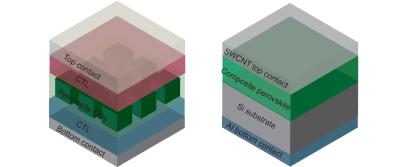Researchers from Russia's Alferov University, ITMO University, Far Eastern Branch of Russian Academy of Sciences, Peter the Great St. Petersburg Polytechnic University, Skolkovo Institute of Science and Technology and China's Qingdao Innovation and Development Center have developed a novel design for a perovskite electrochemical cell for light-emission and light-detection, where the active layer consists of a composite material made of halide perovskite microcrystals, polymer support matrix, and added mobile ions.
Schematic diagrams of (a) the typical PeLED device structure, where CTL - charge transfer layer, QD - quantum dots and (b) the team's PeLEC device structure, where SWCNT - single-walled carbon nanotubes. Image from Opto-Electronic Advances.
The team explained that while halide perovskite light-emitting devices exhibit exceptional properties such as high efficiency, high color purity, and broad color gamut, their industrial integration generally suffers from the technological complexity of devices' multilayer structure alongside in-operation induced heating poor stability. Halide perovskite light-emitting electrochemical cells are a novel type of perovskite optoelectronic device that differs from the perovskite light-emitting diodes by a simple monolayered architecture.
The team reported perovskite light-emitting electrochemical cells that consist of a silicon substrate, multifunctional single composite perovskite layer (a mixture of halide perovskite microcrystals, polymer support matrix, and added mobile ions), and transparent single-walled carbon nanotube film top contact. Due to silicon's good thermal conductivity, the device endures 40% lower thermal heating during operation compared to conventional ITO/glass substrate. Moreover, when a positive bias is applied to the device it yields a luminance of more than 7000 cd/m2 at 523 nm (green color). When a negative bias is applied to the device it operates as a photodetector with a sensitivity up to 0.75 A/W (for wavelength in blue or UV regions), specific detectivity of 8.56∙1011 Jones, and linear dynamic range of 48 dB. The technological potential of such a device is proven by the demonstration of a 24-pixel indicator display as well as successful device miniaturization by the creation of electroluminescent images with the smallest features less than 50 μm.
Not only do perovskite light-emitting electrochemical cells imply having a much simpler architecture and design with one single functional layer replacing multiple active, charge-separation and transport layers of perovskite light-emitting diodes, but perovskite light-emitting electrochemical cells can also possess all the extraordinary properties of LEDs, such as high efficiency, high color purity, and broad color gamut.
The reason why perovskite light-emitting electrochemical cells are capable of doing that is completely different from LEDs' operation principle: when electrical bias is applied to the device, mobile positive and negative ions inside of the perovskite layer migrate towards corresponding electrodes dynamically forming a p-i-n structure inside of the perovskite layer, which allows effective electron-hole recombination with photon emission. Comprehensive research on various back-ups to conventional LED technology is a valuable source of diversifying the pool of industrial opportunities.
The reported device demonstrates exceptional light-emitting and light-detecting (“dual-functionality”) characteristics alongside an enhanced in-operation heating durability. This is possible due to the utilization of silicon substrate in the perovskite light-emitting electrochemical cells design. Silicon material is one of the stepping stones of the CMOS technology - complementary metal–oxide–semiconductor technology – technology used in manufacturing of all semiconductor chips, displays, etc. Integration of such an emerging material like perovskite material with silicon brings the R&D community one step closer to obtaining an industrial perovskite light-emitting electrochemical cell.
The broader context benefit of the reported device design is its ITO-free transparent electrode based on single-walled carbon nanotubes. ITO - Indium-Tin Oxide- is a transparent conductive material widely used in perovskite photovoltaics and optoelectronics. Indium is a depleting element and, thus, the replacement of ITO by other materials based on earth-abundant elements would aid to prevail the indium deficiency in the industry.




